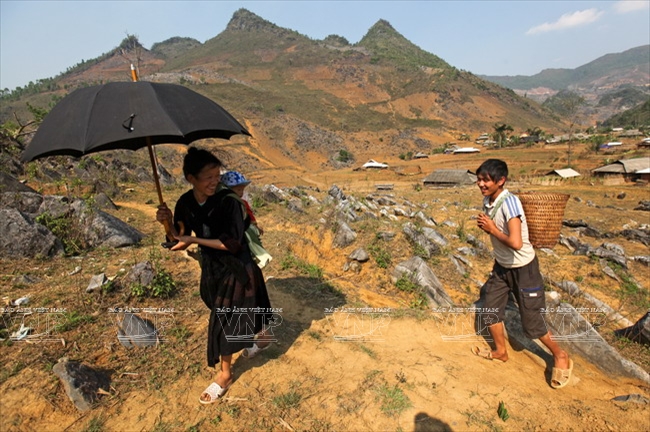From downtown Tua Chua, we travelled along provincial Road 129, driving about 30km of curving roads, over high mountains and deep passes before arriving at the Tua Chua Karst Plateau. Our reward after the difficult trip was enjoying the natural magnificent views of the northwestern forests and mountains.
Tua Chua Karst Plateau belongs to the two communes of Sin Chai and Ta Phin. The rugged karst rocks here are not as high as those in Dong Van Karst Plateau in Ha Giang Province, but they are formed into hills, running up and down, and are scattered along provincial Road 129. The local weather is not harsh and it favours local people in a developing economy. They can grow corn, rice and fruit trees such as plum and peach.
We met Ha Mac and his wife from Seo Phin Hamlet when they were plowing the narrow land between the rugged rocky land. The husband rode the buffalo to plow the soil into rows in front while his wife walked behind to sow the corn seeds. Sometimes, the animal stopped for a while, then continued working.
Mac said that the buffaloes on this highland plateau are sensitive. They would stop walking if the plow hit some stones, and thanks to that the local people’s tool would rarely be damaged.
Watching the ethnic couple working hard in the rocky land to sow the seeds (being their hope for life), we truly acknowledged how hard the life of the local people is, but what a good co-existence between man and nature it is.
 Part of the Tua Chua Karst Plateau seen from high above.  Nature favours the Mong people. Photo: Viet Cuong/VNP
|
Hamlets of the ethnic Mong Si, or Red Mong, people are located here and there on the Tua Chua Plateau. Their houses are built with a unique architecture that attracted the attention of visitors. For example, the house of a local, Thao A Mang, has a stone roof. He said that he had to travel up to the Da River region to find suitable stones, and then transported them by horse down the mountain, and finally by bus to his hamlet. The roof cost him about 90 million dong, equivalent to the value of three buffaloes.
We followed To Van Tuan, deputy head of Tua Chua District’s Agricultural Department, to visit the local relic of Vang Long Citadel. According to historical records, the citadel was built more than two centuries ago and has been rated as an architectural work of art, with cultural and historical value.
The citadel was built in a closed circle by hand and with stones without any cement. The stone plates are arranged in a scientific way, with the large ones sitting on the base and the smaller ones on top. The work is three meters high and its surface is more than one meter wide, which provides enough space for both men and horses to walk on.
The one-day trip to Tua Chua Karst Plateau is truly too short for visitors to totally enjoy its magnificent beauty, which looks like a water color painting. Before leaving, we climbed to a high spot to have one more look at the panoramic view of this natural masterpiece so as to preserve its beauty in our mind.
Photos: Viet Cuong & Hoang Ha










